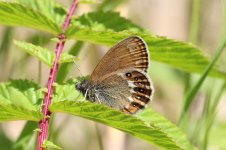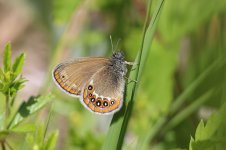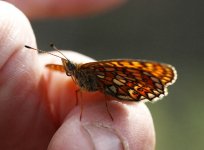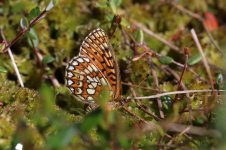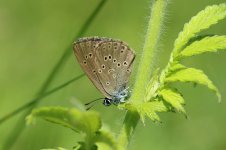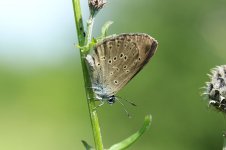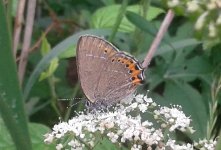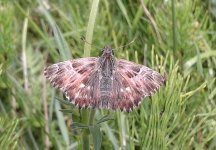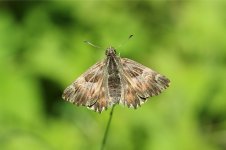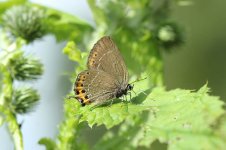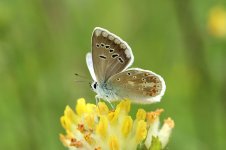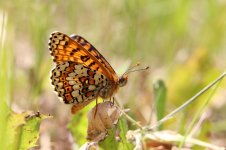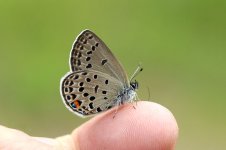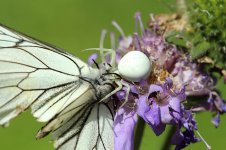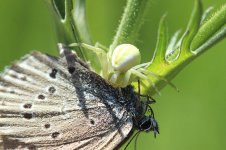Not hijacking your thread here, just curious what's happening there as you haven't posted for a while?
Been in South Africa for three weeks

Below in my last day before I departed, update from last couple of days to follow.
4-8 June. Flight of the Fritillaries.
Early June, season cranking up, many excellent butterflies now on the wing, including many of the rarer localised species, not least several fritillaries.
With a departure from Lithuania for three weeks imminent, I hoped for good weather in these last few days in the country and, fortunately, was duly rewarded – sandwiching days of rain, skies were blue and temperatures good on the 4th, 6th and 8th. Time to make hay ... travelling quite extensively, I visited some of my favourite sites in central and eastern areas, good butterflies at all.
4 June.
Started out not too far from Ukmerge,
Clouded Apollos still flying, plus a range of others including
Small Pearl-bordered Fritillary and
Little Blue, but the highlight of the day was surely checking out one site where I had seen a tatty
Glanville Fritillary moderately late in the season in 2016. A dry sunny slope rich on flowers, it was simply a delight on this day – no tatty
Glanville Fritillaries to report, but instead a splendid emergence of at least 16 most pristine individuals. A highly localised species in Lithuania, rare it is that I see more than than a few
Glanville Fritillaries in any given season, so this was a treat indeed.
Failed to find
Large Heath at one nearby location, but did add my first
Black-veined White on the year.
6 June.
Only a few hours to spare, squashed in between work commitments, but with a hot sun shining down, I could not resist popping out to one site not too far from the capital. And good that I did – on marsh and nearby meadow, 17 species noted in a fairly short period. More than that however, a few real classics amongst them – alongside some stunning
Marsh Fritillaries, I finally found the main butterfly I was seeking. The species in question was another listed in the Lithuanian Red Data Book, the rather diminutive
Scarce Heath. A fairly dark butterfly, the underwings are decorated with a series of small orangy pearls, most exquisite. Found a total of five, all in very fresh condition.
Second attempt in a row, I did however fail to find
Large Heath, a species that should occur alongside. Nearby meadows added my first
Large Skipper of the season.
8 June.
Less than 24 hours later, I would be on a plane heading out of the country. With a three-week absence, I feared I would miss key flight periods for a number of localised species, one of which being
Alcon Blue, another
Bog Fritillary. With sun on this day, I hoped for an early
Alcon Blue and sincerely hoped for a
Bog Fritillary, a species that should already be on the wing.
Tried a couple of localities in the morning, including areas that I saw the range-restricted
Alcon Blue the previous year, but no joy. Couldn't complain too much however, as one meadow in particular proved most excellent – amongst more commonplace
Heath Fritillaries, at least two
False Heath Fritillaries and, more impressive, no less than five
Knapweed Fritillaries. This last species is always a challenge to find in Lithuania, many a year goes by without me seeing one. This particular site though seems reliable – I saw one at the same locality a week earlier and three on the same slopes in 2016. Also here, several
Mazarine Blues, one
Little Blue, loads of
Common Blues, four
Large Skippers, one
Wall Brown and my first
Small Tortoiseshell for a month, clearly generation two about to appear.
Onward to the next target of the day – specialist of raised bogs, wellington boots are the order of the day, all of its favoured localities require quite some squelching about! I have previously seen this species only in Cepkaliai Bog, but certainly did not have time to travel to that locality this day, so tried instead bogs in the heart of forestland not too far south of Vilnius. Had already tried this locality a couple of times in the preceding week, but was still hoping for luck. Walking out into the bog, soon encountered the tail-end of the
Baltic Grayling season, still one or two flitting from pine to pine, while few
Small Pearl-bordered Fritillaries also zipped about, so too the last of the spring emergence of
Green Hairstreaks. Had to pause a while while a cloud shut out the sun for a while, but resuming, I then found the first of the target species, white-centred spots lining the rear underwing, a
Bog Fritillary. Found three in all, success!
Rounded off with a wander in nearby meadows, added my ninth fritillary species of the week – four
Queen of Spain Fritillaries. Indeed, flight of the fritillaries.
BALTIC YEAR LIST
47. Bog Fritillary
48. False Heath Fritillary
49. Black-veined White
50. Scarce Heath
51. Large Skipper
And with that, as I departed Lithuania for three weeks, I'd recorded 51 species in Lithuania so far in 2017, a total that compares favourably to the 47 at the same time in 2016.







